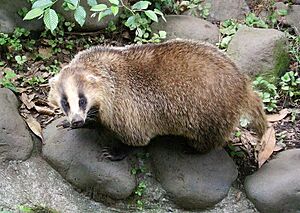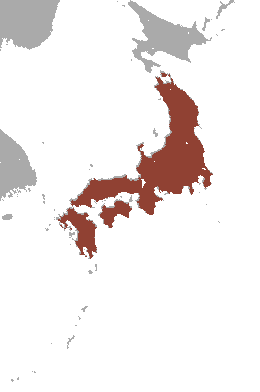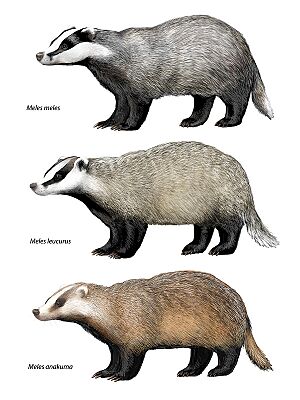Japanese badger facts for kids
Quick facts for kids Japanese badger |
|
|---|---|
 |
|
| At Inokashira Park Zoo, Tokyo | |
| Conservation status | |
| Scientific classification | |
| Genus: |
Meles
|
| Species: |
anakuma
|
 |
|
| Japanese badger range | |
The Japanese badger (Meles anakuma) is a type of carnivoran animal. It belongs to the Mustelidae family, which includes weasels and their relatives. This badger lives only in Japan, making it endemic to the country.
You can find Japanese badgers on the islands of Honshu, Kyushu, Shikoku, and Shōdoshima. They are related to the European badger (M. meles) and the Asian badger (M. leucurus). In Japan, people call them anaguma (穴熊), which means "hole-bear," or mujina (むじな, 狢).
Contents
What Does a Japanese Badger Look Like?
Japanese badgers are usually smaller than European badgers. Males are about 79 cm (31 in) long, and females are around 72 cm (28 in) long. Their tails are between 14 and 20 cm (5.5 and 7.9 in) long. They are similar in size or slightly larger than Asian badgers.
Adult badgers typically weigh from 3.8 to 11 kg (8.4 to 24.3 lb). For example, in the Tokyo area, female badgers weighed about 6.6 kg (14.6 lb), and males weighed about 7.76 kg (17.1 lb). Their bodies are stocky, and their legs are short.
Their front paws have strong claws, which are great for digging. The claws on their back paws are smaller. Their fur is long and gray-brown on the outside, with short black fur underneath. Their faces have black and white stripes, but these stripes are not as clear as those on the European badger. The dark color is mostly around their eyes.
Where Did Japanese Badgers Come From?
Badgers are not found on the island of Hokkaido. However, a related type of badger, M. leucurus, lives in Korea. This suggests that the ancestors of Japanese badgers likely came to Japan from the southwest, possibly through Korea.
Scientists have studied their genes and found big differences between Japanese and Asian badgers. They used to think these two types were the same species. Genetic studies also show that Japanese badgers are very similar to each other, meaning they have less genetic variety.
Life and Behavior
Like other badgers in the Meles group, Japanese badgers are nocturnal, meaning they are active at night. They also hibernate during the coldest months of the year, sleeping through winter.
Reproduction
Female badgers start mating and having babies when they are about 2 years old. They usually give birth to two or three cubs in the spring, around March or April. They mate again soon after giving birth. However, the fertilized egg does not start growing right away. This is called delayed implantation, and the egg only starts to develop in February of the next year.
Japanese badgers tend to be more solitary than European badgers. They don't live in large social groups or clans. Also, male and female badgers do not form lasting pairs. During mating season, a male badger's home area might overlap with the areas of two or three females. Badgers whose areas overlap might communicate with each other by leaving their scent marks.
Where Do Japanese Badgers Live?
These badgers live in different kinds of forests and woodlands. They can adapt to various tree-filled environments.
Japanese Badger in Folklore
In Japanese stories and myths, badgers are known as mujina. These mujina are believed to be shapeshifters, meaning they can change their form. In an old Japanese book called the Nihon Shoki, it says that mujina could sing and change into human beings.
What Do Japanese Badgers Eat?
Like other badgers, the Japanese badger eats many different things, making them omnivorous. Their diet includes earthworms, beetles, various berries, and persimmons. What they eat changes depending on what food is available during different seasons.
Studies of their droppings show that they eat the most earthworms in warmer months. In summer, they also eat berries and small insects. When earthworms are harder to find in cooler months, Japanese badgers eat more wild berries, such as Rubus palmatus and Rubus hirsutus. They eat the most persimmons in the fall when these fruits are ripe and plentiful.
Challenges Japanese Badgers Face
Even though Japanese badgers are still common, the areas where they live have become smaller recently. In 2003, they lived in about 29 percent of Japan. But over the next 25 years, this area shrank by 7 percent.
More land is being used for buildings and farms, which takes away the badgers' homes. Also, new animals like raccoons, which were brought to Japan, compete with badgers for food and space.
Hunting badgers is allowed in Japan, but it has become much less common since the 1970s. However, in 2017, there was a concern about an increase in badger hunting in Kyushu. This was partly because local governments offered rewards for hunting badgers, and badger meat became more popular in restaurants. People worried that too many badgers might be hunted, which could harm their population.
See also
- Mujina, a badger creature from Japanese folklore
- Blakiston's Line, a natural boundary line in Japan that separates where certain animal species live



